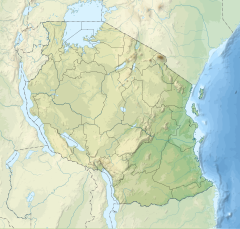
The Kihansi spray toad is a small toad endemic to Tanzania. The species is live-bearing and insectivorous. The Kihansi spray toad is currently categorized as Extinct in the Wild by the International Union for Conservation of Nature (IUCN), though the species persists in ex situ, captive breeding populations.
Nectophrynoides wendyae, also known as the Uzungwe Scarp tree toad or Wendy's forest toad, is a terrestrial toad in the family Bufonidae. It is endemic to Tanzania and is only known from a single valley in the Udzungwa Mountains. The specific name wendyae honours Wendy Clarke, the describer's wife.

Adenomus kandianus is a species of toad in the family Bufonidae endemic to Sri Lanka. It is a high-altitude species known only from few localities. The specific name kandianus means "from Kandy" and seems to suggest that the type material came from near the city of Kandy.
Sclerophrys fuliginata is a species of toad in the family Bufonidae. The specific name fuliginata is Latin for "sooty", in reference to the species' appearance of a more or less diffusely uniform exterior color and pattern. It is also known as the Shaba Province toad or sooty toad. It is found in the southern Democratic Republic of the Congo, southeastern Tanzania, and northern Zambia.

Rhinella jimi is a species of toads in the family Bufonidae. It is endemic to northeastern Brazil and known between Bujaru in northeastern Pará and Maranhão in the north, south to Bahia and Vitória, Espírito Santo. Prior to its description in 2002, it was confused with Rhinella schneideri. The specific name jimi honors Jorge Jim, a Brazilian herpetologist. Common name Jimi's toad has been coined for it.
Sclerophrys langanoensis is a species of toad in the family Bufonidae. It is endemic to northern Rift Valley in Ethiopia, where it has been recorded from Lake Langano and the Awash National Park; the latter population might represent a distinct species. It is likely that this species will also be found in Eritrea and Somalia. Common name Lake Langano toad has been coined for it.
Mertensophryne melanopleura is a species of toad in the family Bufonidae. It is known from its type locality, the Upemba National Park in southern Democratic Republic of the Congo, and from eastern Angola and south of Ndola in northern Zambia.
Sclerophrys reesi, also known as Merara toad or Rees' toad, is a species of toad in the family Bufonidae. It is endemic to southern Tanzania and is only known from the Kihansi–Ulanga River floodplain from elevations of 200–500 m (660–1,640 ft) above sea level. It is named after Allen Rees, a principal game warden for the Tanzanian Wildlife Department who collected the type series.
Sclerophrys urunguensis is a species of toad in the family Bufonidae. It is found in the border area of Tanzania and Zambia, near the southeastern corner of Lake Tanganyika. One recent Tanzanian record is from close to the border with Burundi. Morphological characters suggests that it actually belongs to the genus Poyntonophrynus, but the formal move to that genus has not been made. Common name Urungu toad has been coined for it.
Nectophrynoides laevis, the smooth forest toad, is a species of toad in the family Bufonidae.
Nectophrynoides minutus is a species of toad in the family Bufonidae. It is endemic to Tanzania and is known from the Uluguru and Rubeho Mountains. Common names small viviparous toad, minute tree toad, and dwarf forest toad have been proposed for it.
Nectophrynoides pseudotornieri is a species of toad in the family Bufonidae. It is endemic to the Uluguru Mountains in eastern Tanzania. Common names pseudo forest toad and false Tornier's viviparous toad have been proposed for it. Its specific name refers to its similarity to Nectophrynoides tornieri.
Nectophrynoides vestergaardi, also known as the Vestergaard's forest toad, is a species of toad in the family Bufonidae. It is endemic to the West Usambara Mountains, Tanzania. It is named in honour of Martin Vestergaard, the Danish biologist who was the first to recognize that the population now described as Nectophrynoides vestergaardi was a new species.
Nectophrynoides viviparus is a species of toad in the family Bufonidae. It is endemic to Tanzania. Common names robust forest toad and Morogoro tree toad have been coined for it.

Mertensophryne usambarae is a critically endangered species of toad in the family Bufonidae. It is endemic to the foothills of the East Usambara Mountains, northeastern Tanzania.
Nectophrynoides laticeps is a species of toad in the family Bufonidae. It is endemic to the Ukaguru Mountains of Tanzania. Common name wide-headed viviparous toad has been proposed for it.
Nectophrynoides paulae is a species of toad in the family Bufonidae. It is endemic to the Ukaguru Mountains of Tanzania.
Dendrophryniscus skuki is a species of toad in the family Bufonidae. It is endemic to northeastern Brazil and only known from its type locality in the municipality of Itacaré, state of Bahia. This species is dedicated to herpetologist Gabriel "Gabo" Skuk, the species describer's friend who perished in a diving accident.
Pelophryne saravacensis, also known as Sarawak dwarf toad, is a species of toad in the family Bufonidae. It is endemic to Borneo and only known from Sarawak ; there are records from at least four localities representing three different divisions.
Ansonia pilokensis, also known as the Pilok stream toad, is a species of toad in the family Bufonidae. As currently known, it is endemic to Kanchanaburi Province in western Thailand, on the eastern slopes of the Bilauktaung Range. Its true range possibly extends into adjacent Myanmar. Geographically, its range is close to Ansonia thinthinae from the western slopes of the Bilauktaung Range, but A. thinthinae is more closely related to the geographically more distant Ansonia kraensis than to A. pilokensis.





